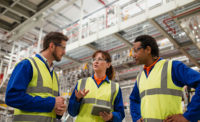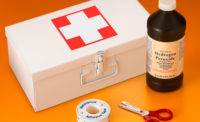Slip and fall accidents remain one of the most pervasive and costly risks for businesses and employees. In 2020, the U.S. Bureau of Labor Statistics (BLS) reported 211,640 injury cases involving falls, slips, and trips — with many more unreported. Of the reported incidents, 805 have tragically ended in fatalities, and 20% result in three or more days of missed work.1
According to the 2021 Liberty Mutual Workplace Safety Index, more than 33% of the top 10 most disabling workplace injuries are caused by falls, slips, and trips.2 These injuries translate into billions of dollars in lost revenue. The combined impact of falls, slips, and trips costs businesses more than $19 billion annually. That’s a cost no business can afford.
Beyond the financial impact, the risk of falls, slips, and trips can detrimentally affect employee morale and productivity. Working on slippery, potentially hazardous surfaces makes it harder for employees to perform their jobs efficiently, productively, and confidently. Taking action to eliminate these hazards can go a long way toward improving employee safety, satisfaction, retention, and the bottom line.
Find the slip and fall risks
Creating a safer working environment starts with understanding where the risks lie. Approximately 10% of walking surfaces in a building are considered high-risk. Slips and falls from heights such as mezzanines, stairways, and ladders, result in more severe injuries.
Take a comprehensive and proactive approach to reducing slips, trips, and falls risks. Conduct a thorough surface safety audit to inspect and evaluate walking surfaces across the facility. Start with a walk around the facility and note conditions that increase risk. Pay close attention to:
Changes in the walking surface – Slips, trips, and falls are most likely to occur when a person moves from a higher friction surface (like cement) to a lower-friction surface (ice).
Wet environments – In manufacturing facilities that process chemicals, foods, beverages, and other wet products, water, oil, grease, and other liquids are ever-present – liquids that can make already low-friction surfaces even more slippery. Also, look at trenches and round drains that funnel liquids. If employees walk over drains during work, they should be retrofit with drains fabricated with anti-slip technologies.
High-traffic areas – The main walkways and thorough fares are inherently high risk for slips, trips, and falls because there are so many people in one space.
Operation areas – In industrial buildings, employees operate carts, trucks, and forklifts that can be difficult to control on slippery surfaces.
Indoor/Outdoor spaces - Are inside/outside areas such as loading docks and bays exposed to outdoor elements? Are people tracking mud, snow, or water inside from the outdoors?
During the walk, be sure to also:
- Observe the materials currently in place to prevent slips and falls. Are the materials durable, effective, and sufficient to prevent accidents, even when wet?
- Be on the lookout for potential trip hazards, such as neoprene mats or peeling hazard tape on the floors.
- Talk to employees about where they do and don’t feel safe. Listening can be the best way to identify areas where employees have had near misses and want better conditions.
Create a prevention and mitigation plan
Once the audit is complete, it’s time to develop and implement a plan to mitigate the facility's slip, fall, and trip risks. The goal is to ensure high-risk surfaces have an adequate coefficient of friction (COF) – the measurable resistance between two surfaces. COF is measured between 0 and 1, with 1 indicating a higher level of friction and safety. National Floor Safety Institute (NFSI) guidelines indicate that a COF of 0.4 or less is unsafe, while a COF of 0.6 or higher is considered safer.
Sometimes it’s obvious which surfaces are slippery and which are not. If several falls occur in the same place, a more in-depth surface analysis is called for. To get the most detailed readings, use a tribometer to measure COF. Tribometers can also measure COF under different conditions, such as wet, dry, or greasy. Another option is to bring in a safety consultant who will do a formal safety assessment and perform the COF readings simultaneously.
If the safety assessment uncovered surfaces that don’t meet an adequate COF, or there were warning and “Slippery When Wet” signs, it’s time to consider retrofitting those walking areas with new materials to permanently mitigate the issues. Installing anti-slip coated metal in those areas can eliminate over 90% of slips, trips, and falls. When selecting a material to retrofit walking surfaces, look for one that is NSFI-certified as “High Traction.”
Use high-traction materials
Metal-bonded surface technologies that create thousands of tiny, random surface peaks and valleys on a surface have a high coefficient of friction. The structural peaks retain their anti-slip properties after years of wear, even when wet from water or oils. The surface coating maintains its anti-slip properties despite the presence of oils, water, detergent, and other liquids. The surface is manufactured without grit or added granules that can contaminate products, damage machinery, and create health hazards.
Nearly any surface can be retrofitted with high-traction metal-bonded pieces, including ladder rungs, stair treads, nosings, grates, drain and trench covers, and large flooring areas. This high-tech process is compatible with steel, stainless steel, and aluminum to create hard, durable surfaces. When treated, the steel and stainless surfaces result in a bond strength of over 3,500 psi and a file hard surface of over 55 on the Rockwell “C” scale. Aluminum, being a softer element, bonds at over 2,000 psi.
Although installing anti-slip walkways and surfaces in the design and construction phase is always best, it’s not an option for the second and third tenants in a building. Leaving high-risk areas unaddressed will likely end up costing more in maintenance resources, productivity, downtime, medical care, and potential litigation. Retrofitting these areas with high-traction solutions will remediate the issues, improve employee safety and satisfaction, enhance productivity, reduce maintenance time, and minimize downtime.
References
1. “Census of Fatal Occupational Injuries - 2020”, U.S. Bureau of Labor Statistics
2. 2021 Liberty Mutual Workplace Safety Index









